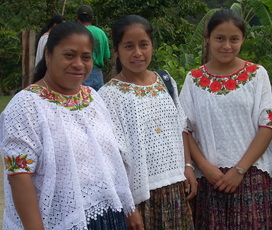Tamahú, Guatemala
April 17 - 25, 2020
April 17 - 25, 2020
Guatemala is among the most beautiful countries in Central America, with heavily forested mountain regions, Mayan ruins, lakes, volcanoes and orchids. Its indigenous population, the Maya, make up about half of its total populace and continue to speak Mayan languages and follow Mayan traditions.
Tamahú is located in Guatemala's eastern highlands, approximately 100 miles northeast of Guatemala City, and is nestled amid beautiful mountains that are home to more than 10,000 Mayan people of the Pocomchi and Q'eqchi tribes.
Guatemala's beauty and strength of identity have not been matched by its cohesion and prosperity. Guatemalans live in one of the most iniquitous societies in the region where the top 2% control an estimated 58% of the national wealth and where up to 90% of people subsist on less than $2.00/day. The malnutrition rate for children is higher than in some parts of sub-Saharan Africa and more than two-thirds of the population live in extreme poverty. While illiteracy, infant mortality and malnutrition are among the highest in the region, life expectancy is among the lowest.
The near-subsistence farmers of Tamahú continue a generational disadvantage, toiling away on shrinking plots etched into steep hillsides, barely able to grow enough corn and beans to last the year. The worldwide spike in food prices in the last year has increased the amount families spend on basic food staples by about 12 quetzals ($1.54) per day. That's half a day's pay as a hired farm worker! These conditions push families further into desperation.
Mir Pace has been leading groups of high school student volunteers to Tamahú, bringing nutritional, medical, educational, and development assistance since 2003.
Guatemala's beauty and strength of identity have not been matched by its cohesion and prosperity. Guatemalans live in one of the most iniquitous societies in the region where the top 2% control an estimated 58% of the national wealth and where up to 90% of people subsist on less than $2.00/day. The malnutrition rate for children is higher than in some parts of sub-Saharan Africa and more than two-thirds of the population live in extreme poverty. While illiteracy, infant mortality and malnutrition are among the highest in the region, life expectancy is among the lowest.
The near-subsistence farmers of Tamahú continue a generational disadvantage, toiling away on shrinking plots etched into steep hillsides, barely able to grow enough corn and beans to last the year. The worldwide spike in food prices in the last year has increased the amount families spend on basic food staples by about 12 quetzals ($1.54) per day. That's half a day's pay as a hired farm worker! These conditions push families further into desperation.
Mir Pace has been leading groups of high school student volunteers to Tamahú, bringing nutritional, medical, educational, and development assistance since 2003.





